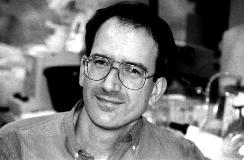RECENTLY TENURED
Elise Kohn came to NCI in 1986 as a fellow in the Medicine Branch's
Clinical Oncology Program and has been in the Laboratory of Pathology since
1987. She received her M.D. in 1983 from the University of Michigan in
Ann Arbor, where she did her internship and residency in internal
medicine.
 My laboratory is exploring the effects of intracellular calcium
homeostasis on cancer growth and dissemination. This interest directs our
current working hypotheses that the modulation of calcium and calcium-driven
signaling events alters cellular activity and gene expression. This work may
point to new directions for cancer therapy.
My laboratory is exploring the effects of intracellular calcium
homeostasis on cancer growth and dissemination. This interest directs our
current working hypotheses that the modulation of calcium and calcium-driven
signaling events alters cellular activity and gene expression. This work may
point to new directions for cancer therapy.
Our current line of research began when we observed that changes in cellular
signaling, including blocking an increase in intracellular calcium, could
abrogate the usual migration of tumor cells in response to growth factors and
cytokines. Through a screening program consisting of motility assays and
calcium-influx experiments, we identified a carboxyamido-triazole compound,
which we call CAI, that inhibits calcium influx and calcium-influx-dependent
signaling events. CAI has proven to be a useful tool in our investigation of
the modulation of calcium concentrations and calcium-linked mechanisms both in
vitro and in vivo.
Our studies have demonstrated that calcium homeostasis plays an important role
in the process of angiogenesis, which is a form of physiologic invasion of new
blood vessels into tissue that occurs during wound healing, pregnancy, and
tumor growth. CAI disrupts the normal function of the cytoskeleton of
endothelial cells, reduces expression of proteolytic enzymes, and decreases
neovascular potential in vitro--all of which are key steps in angiogenesis,
suggesting that CAI may be a useful agent in the treatment of cancer. We have
also observed a marked anti-angiogenic effect of CAI in vivo, in chicken
chorioallantoic membrane (CAM) assays. We are now investigating the immediate
signaling effects of altered calcium balance in the endothelial cells as part
of the hypothesis that calcium homeostasis is important in physiologic, as well
as malignant, invasion.
We are also studying the regulation of gene expression as a function of
calcium modulation, or signaling balance. We developed a human melanoma cell
subline that is resistant to constant exposure to CAI and observed a phenotypic
difference between resistant cells and nonresistant cells. Unexpectedly, the
resistant cells displayed reduced tumorigenic potential as measured by reduced
density-independent growth and reduced tumorigenesis in xenografts of human
tumors in nude mice. This led to a molecular investigation comparing resistant
and nonresistant cells that led to the discovery of several genes that are
currently being cloned.
Early studies found that CAI treatment reversibly inhibited the proliferation
and invasive capacity of more than 25 types of tumor cells. The oral
administration of CAI to human xenograft-bearing mice resulted in a reduction
in total tumor burden and metastatic dissemination without marked toxicity to
normal tissues. Our in vitro and animal observations have led to phase I
clinical trials of CAI in solid-tumor patients with advanced and refractory
cancer. Since the trial was initiated in 1992, more than 60 patients have
received CAI. So far, CAI has been well tolerated and has resulted in disease
stabilization, as characterized by a reduction in both the size and number of
tumors and by improved symptoms. Both the CAI study and a trial of CAI in
combination with Taxol are ongoing and open to patient entry.
Louis Staudt received his M.D. and Ph.D. degrees from the University of Pennsylvania School of Medicine in Philadelphia in 1982. In 1984, he
joined David Baltimore's laboratory at the Whitehead Institute in Cambridge,
Mass., as a postdoc. Since 1988, Staudt has been a senior staff fellow in the
Metabolism Branch, NCI.
 The major effort of my laboratory is currently focused on understanding
the molecular pathogenesis of human leukemias and lymphomas caused by nuclear
oncogenes. This effort often coincides with the lab's secondary interest--the
molecular regulation of B-lymphocyte development. Our early work defined a
novel lymphoid-restricted transcription factor, Oct-2, which was a founding
member of the POU domain class of homeobox transcription factors. Now we are
studying two lymphoid malignancies: diffuse large-cell lymphoma caused by the
BCL-6 oncogene and t(4;11) acute lymphoblastic leukemia caused by a
fusion oncoprotein involving the MLLandAF-4 genes.
The major effort of my laboratory is currently focused on understanding
the molecular pathogenesis of human leukemias and lymphomas caused by nuclear
oncogenes. This effort often coincides with the lab's secondary interest--the
molecular regulation of B-lymphocyte development. Our early work defined a
novel lymphoid-restricted transcription factor, Oct-2, which was a founding
member of the POU domain class of homeobox transcription factors. Now we are
studying two lymphoid malignancies: diffuse large-cell lymphoma caused by the
BCL-6 oncogene and t(4;11) acute lymphoblastic leukemia caused by a
fusion oncoprotein involving the MLLandAF-4 genes.
Diffuse large-cell lymphoma, which is a malignancy of mature B lymphocytes,
accounts for 40% of all cases of non-Hodgkin's lymphoma. In 40% of diffuse
large cell lymphomas, theBCL-6 gene is rearranged by translocations
that leave the BCL-6 coding region intact but that substitute its
promoter region with regulatory regions from other genes. The BCL-6 gene
encodes a zinc-finger transcription factor that shares a
121-residue
amino-terminal homology domain, the POZ domain, with a subset of other
zinc-finger proteins.
In studies involving normal lymphocytes, we have shown that BCL-6 mRNA
is highly expressed in mature B cells but not in terminally differentiated,
antibody-producing plasma cells, and that activation of lymphocytes
downregulates BCL-6 mRNA. The BCL-6 protein is phosphorylated and is
expressed highly in the germinal center, the site where memory B cells and
plasma cells are generated. These findings have led to our working hypothesis
that BCL-6 expression must be downregulated for terminal B cell
differentiation to occur and that such regulation is absent in diffuse large
cell lymphoma. BCL-6 presumably transforms B lymphocytes by regulating the
transcription of key target genes. We have identified high-affinity binding
sites through which BCL-6 functions as a potent transcriptional repressor, and
we have shown that its POZ domain is necessary and sufficient for repression.
Currently, we are trying to identify the mechanism underlying this
transcriptional repression and the natural targets of BCL-6 repression.
Our second major project is aimed at understanding the molecular pathogenesis
of t(4;11) pro-B-cell acute lymphoblastic leukemia in which theAF-4
gene is fused to the MLL gene. This translocation is found in 60% of
acute lymphoblastic leukemia cases in children under 12 months old. The MLL
gene, which is a homologue of the Drosophila melanogaster regulatory
protein, trithorax, is translocated to several different chromosomal loci in a
variety of acute leukemias. Each translocation generates an in-frame fusion
protein between the amino terminus of MLL and the carboxy terminus of the
fusion partner. Our interest in this leukemia stems from our cloning of a
lymphoid-restricted homologue of the AF-4 gene, termed LAF-4.
Neither LAF-4 nor AF-4 show significant homology to previously
cloned transcription factors. We have shown that LAF-4 is a nuclear protein and
have found that both LAF-4 and AF-4 have potent transcriptional activation
domains. Thus, LAF-4 and AF-4 are the founding members of a new family of
nuclear transactivator proteins. Intriguingly, the AF-4 activation domain is
retained in the MLL-AF-4 fusion oncoprotein, suggesting that this domain may
contribute to the oncoprotein's transforming properties.
Table of Contents
 My laboratory is exploring the effects of intracellular calcium
homeostasis on cancer growth and dissemination. This interest directs our
current working hypotheses that the modulation of calcium and calcium-driven
signaling events alters cellular activity and gene expression. This work may
point to new directions for cancer therapy.
My laboratory is exploring the effects of intracellular calcium
homeostasis on cancer growth and dissemination. This interest directs our
current working hypotheses that the modulation of calcium and calcium-driven
signaling events alters cellular activity and gene expression. This work may
point to new directions for cancer therapy.
 The major effort of my laboratory is currently focused on understanding
the molecular pathogenesis of human leukemias and lymphomas caused by nuclear
oncogenes. This effort often coincides with the lab's secondary interest--the
molecular regulation of B-lymphocyte development. Our early work defined a
novel lymphoid-restricted transcription factor, Oct-2, which was a founding
member of the POU domain class of homeobox transcription factors. Now we are
studying two lymphoid malignancies: diffuse large-cell lymphoma caused by the
BCL-6 oncogene and t(4;11) acute lymphoblastic leukemia caused by a
fusion oncoprotein involving the MLLandAF-4 genes.
The major effort of my laboratory is currently focused on understanding
the molecular pathogenesis of human leukemias and lymphomas caused by nuclear
oncogenes. This effort often coincides with the lab's secondary interest--the
molecular regulation of B-lymphocyte development. Our early work defined a
novel lymphoid-restricted transcription factor, Oct-2, which was a founding
member of the POU domain class of homeobox transcription factors. Now we are
studying two lymphoid malignancies: diffuse large-cell lymphoma caused by the
BCL-6 oncogene and t(4;11) acute lymphoblastic leukemia caused by a
fusion oncoprotein involving the MLLandAF-4 genes.